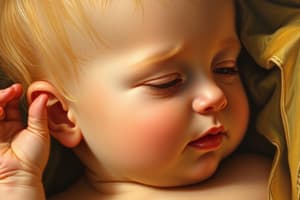Podcast
Questions and Answers
At what month does an infant typically show the ability to sit securely without support?
At what month does an infant typically show the ability to sit securely without support?
- 6 months
- 7 months
- 8 months (correct)
- 9 months
Which milestone corresponds with the infant turning from back to front without experiencing head lag?
Which milestone corresponds with the infant turning from back to front without experiencing head lag?
- 6 months
- 3 months
- 5 months
- 4 months (correct)
What is the typical motor development observed in an infant at 11 months?
What is the typical motor development observed in an infant at 11 months?
- Creeps or crawls (abdomen off floor)
- Pulls self to standing
- Begins to show ability to sit
- Cruises (walks with support) (correct)
When can infants typically hold an object for a few minutes before dropping it?
When can infants typically hold an object for a few minutes before dropping it?
Which developmental milestone involves an infant beginning to show thumb opposition?
Which developmental milestone involves an infant beginning to show thumb opposition?
At what age is the infant's immune system functional enough to produce IgG and IgM?
At what age is the infant's immune system functional enough to produce IgG and IgM?
What is the typical heart rate range for an infant by the end of the first year?
What is the typical heart rate range for an infant by the end of the first year?
What change occurs in the respiratory rate of infants during their first few months?
What change occurs in the respiratory rate of infants during their first few months?
When does physiological anemia typically occur in infants?
When does physiological anemia typically occur in infants?
What is the significance of brown fat in infants?
What is the significance of brown fat in infants?
What is recommended to introduce to an infant's diet?
What is recommended to introduce to an infant's diet?
At what age does fear of strangers typically peak in infants?
At what age does fear of strangers typically peak in infants?
What is a common emotional response when a primary caregiver leaves an infant?
What is a common emotional response when a primary caregiver leaves an infant?
When should the measles vaccine be administered to children?
When should the measles vaccine be administered to children?
Which of the following is a common choking hazard for infants?
Which of the following is a common choking hazard for infants?
What is the purpose of having a soft toothbrush for infants?
What is the purpose of having a soft toothbrush for infants?
What behavior indicates that an infant recognizes their primary caregiver?
What behavior indicates that an infant recognizes their primary caregiver?
What should not be a part of the vaccination schedule for children?
What should not be a part of the vaccination schedule for children?
At what age does an infant typically start to say simple vowel sounds such as 'goo-goo' or 'gah-gah'?
At what age does an infant typically start to say simple vowel sounds such as 'goo-goo' or 'gah-gah'?
Which reflex is described as being strong at 3 months of age?
Which reflex is described as being strong at 3 months of age?
At what month does the tonic neck reflex completely fade?
At what month does the tonic neck reflex completely fade?
What social behavior peaks around 8 months of age?
What social behavior peaks around 8 months of age?
What play activity is suggested for infants around 10 months of age?
What play activity is suggested for infants around 10 months of age?
Which fine motor skill is typically developed by 7 months?
Which fine motor skill is typically developed by 7 months?
When does an infant's enjoyment in looking at their hands typically occur?
When does an infant's enjoyment in looking at their hands typically occur?
Which developmental milestone is expected to be achieved by 12 months?
Which developmental milestone is expected to be achieved by 12 months?
What is typically observed in infants around 6 months in relation to reflexes?
What is typically observed in infants around 6 months in relation to reflexes?
At what age do infants typically show signs of fear of strangers for the first time?
At what age do infants typically show signs of fear of strangers for the first time?
When is tummy time particularly important for infants?
When is tummy time particularly important for infants?
Which of the following motor skills is developed by 4 months of age?
Which of the following motor skills is developed by 4 months of age?
What type of toys do infants enjoy at 6 months of age?
What type of toys do infants enjoy at 6 months of age?
By what age can an infant typically use objects that are good size for transferring?
By what age can an infant typically use objects that are good size for transferring?
What is a common health concern related to teething in infants?
What is a common health concern related to teething in infants?
What intervention is suggested for infants experiencing gas pain?
What intervention is suggested for infants experiencing gas pain?
Which factor is NOT considered a cause of colic in infants?
Which factor is NOT considered a cause of colic in infants?
What is a recommended preventive measure for diaper rash?
What is a recommended preventive measure for diaper rash?
How often should infants be bathed to prevent miliaria?
How often should infants be bathed to prevent miliaria?
What health complication can arise from the baby bottle syndrome?
What health complication can arise from the baby bottle syndrome?
What is an effective strategy for managing dyssomnia in infants?
What is an effective strategy for managing dyssomnia in infants?
Which intervention is advised if an infant is experiencing frequent spit-ups?
Which intervention is advised if an infant is experiencing frequent spit-ups?
What is a common cause of seborrheic dermatitis in infants?
What is a common cause of seborrheic dermatitis in infants?
Which of the following is considered an intervention for preventing tooth decay related to baby bottle syndrome?
Which of the following is considered an intervention for preventing tooth decay related to baby bottle syndrome?
What is the recommended approach to address skin irritation in infants due to poor hygiene?
What is the recommended approach to address skin irritation in infants due to poor hygiene?
Which symptom is not an indicator of teething?
Which symptom is not an indicator of teething?
What can excessive use of pacifiers lead to in infants?
What can excessive use of pacifiers lead to in infants?
Flashcards are hidden until you start studying
Study Notes
Physiological Changes in Infancy
- During the first year of life, an infant's circulatory system matures, with heart rate slowing to 100-120 beats per minute.
- The infant’s respiratory system also matures, with the breathing rate decreasing to 20-30 breaths per minute.
- The infant's immune system begins to develop, gaining the ability to produce IgG and IgM antibodies.
- Thermoregulation is achieved by six months of age, with brown fat playing a role in temperature control.
- The infant’s gastrointestinal system develops as well, with increased amylase and lipase production to aid digestion and a decrease in the risk of respiratory infection.
Gross Motor Development in Infancy
- A newborn has largely reflex actions and by two months of age, can hold their head up when prone.
- By four months, infants can bear partial weight on their feet, and by five months, can readily turn from front to back and back to front.
- The ability to sit unsupported develops by eight months.
- Crawling, crawling with the abdomen off the floor, appears around nine months.
- Pulling to a standing position is seen by ten months, and cruising (walking with support) by eleven months.
Fine Motor Development in Infancy
- An infant’s fine motor skills progress to the point of keeping hands un-fisted with the ability to follow objects with their eyes by one month.
- At two months, an infant can hold an object for several minutes.
- By four months, infants bring their hands together and pull at their clothes, also showing thumb opposition - the ability to touch the thumb to the tips of other fingers.
- The ability to transfer objects from hand to hand occurs at seven months and advanced eye-hand coordination is achieved by eight months.
Socialization and Language Development in Infancy
- A newborn infant can differentiate between faces and other objects, and by two months, has a social smile and makes cooing noises.
- The ability to laugh out loud develops by three months.
- By six months, an infant may say simple vowel sounds like "goo-goo" or "gah-gah".
- Fear of strangers develops by seven months and peaks at eight months.
- The first word "dada" generally occurs by nine months and by twelve months babies typically have two words plus "mama" and "dada" in their verbal repertoire.
Time Reflexes Fading in Infancy
- Grasp reflexes gradually fade by two months of age.
- The Landau reflex is strong by three months and fades by eleven months.
- Stepping reflexes and tonic neck reflexes fade by four months.
- The Moro and tonic neck reflexes gradually fade by six months.
Play in Infancy
- A newborn enjoys watching the face of their primary caregiver and needs playtime in a prone position.
- By two months, they enjoy bright colored mobiles.
- Playing with their hands is a common activity by three months.
- By four months infants need space to practice turning.
- They handle rattles well by five months and enjoy bathtub toys and rubber rings for teething by six months.
- By seven months, they generally like objects that are good for transferring.
- They enjoy manipulation, rattles, and toys of different textures by eight months.
- By nine months infants need safe space to creep.
- They play games like patty-cake and peek-a-boo by ten months and cruising can be their main activity by eleven months.
Emotional and Social Needs in Infancy
- The infant’s differentiation between faces and other objects becomes more pronounced by one month of age.
- An infant can recognize their primary caregiver and enjoys their interaction, showing displeasure if they leave.
- By five months, an infant may show displeasure when an object is taken away.
- Six months of age marks an increased awareness of familiar caregivers versus strangers, with infants typically drawing back from unfamiliar people.
- Fear of strangers further develops by seven months and peaks at eight months.
- By nine months, infants recognize changes in tone of voice and begin to cry when scolded.
Immunizations
- The timing of immunizations is dictated by a schedule, which should not be restarted if there has been a delay of months or years.
- Moderate fever, malnutrition, and respiratory infection are not contraindications for most immunizations.
- Measles vaccine should be given as soon as the child is nine-months-old.
Contraindications for Immunization
- Contraindications for immunizations include children with clinical AIDS and children who had convulsions or shock within three days of a previous dose.
Common Health Problems of Infants
- Teething is marked by sore gums, and restlessness during the day may be associated with teething pain. This usually precedes the eruption of a tooth.
- Thumb sucking in infants is a common practice that can cause malocclusion - or improper alignment of teeth - if it is done too often. Pacifiers can also lead to malocclusion.
- Head banging – can be a sign of autism, even if the child is otherwise developing normally.
Neonatal Common Health Problems
- Constipation: more common in bottle-fed infants, addressing this can involve: adding fluids or carbohydrates in the formula, adding foods with bulk, such as fruits and vegetables, or dilating the anal sphincter.
- Loose stools - treatment is often related to treating the underlying cause of the loose stools.
- Colic: a paroxysmal (sudden, brief, and intense) abdominal pain that occurs in infants under three months of age, accompanied by a red and flushed face, clenched fists, and a tense abdomen. This can be related to overfeeding, gas distention, poorly developed sphincter, or a sensitivity to milk formula or ingredients.
- Spitting up: a potential sign of overfeeding, a need to burp more frequently, or a need to change milk formula.
- Skin irritation: can be due to poor hygiene, irritation from urine or feces, or detergents.
- Seborrheic dermatitis – or cradle cap – is a form of skin irritation caused by poorly maintained hygiene, potentially addressed with mineral oil and a shampoo bath in the morning.
- Miliaria – or prickly heat – a cluster of pinpoint rashes during hot weather appearing around the neck, nose, and ears, is commonly associated with hot weather. It can be prevented by bathing twice daily and avoiding excessive amounts of clothing.
- Baby-bottle syndrome - can be caused by putting a bottle in an infant’s mouth during sleep, risking aspiration, tooth decay, ear infections, etc.
- Sleep problems: dyssomnia, confusional arousal, sleepwalking, and nightmares are all possible sleep problems in infants.
Additional Important Information
- Soft toothbrushes should be used for infants. Infant toothbrushes should be used 2 times a day once teeth erupt.
- Introducing one food at a time – starting with a single ingredient at a time – allows for easier monitoring of food allergies.
Studying That Suits You
Use AI to generate personalized quizzes and flashcards to suit your learning preferences.




